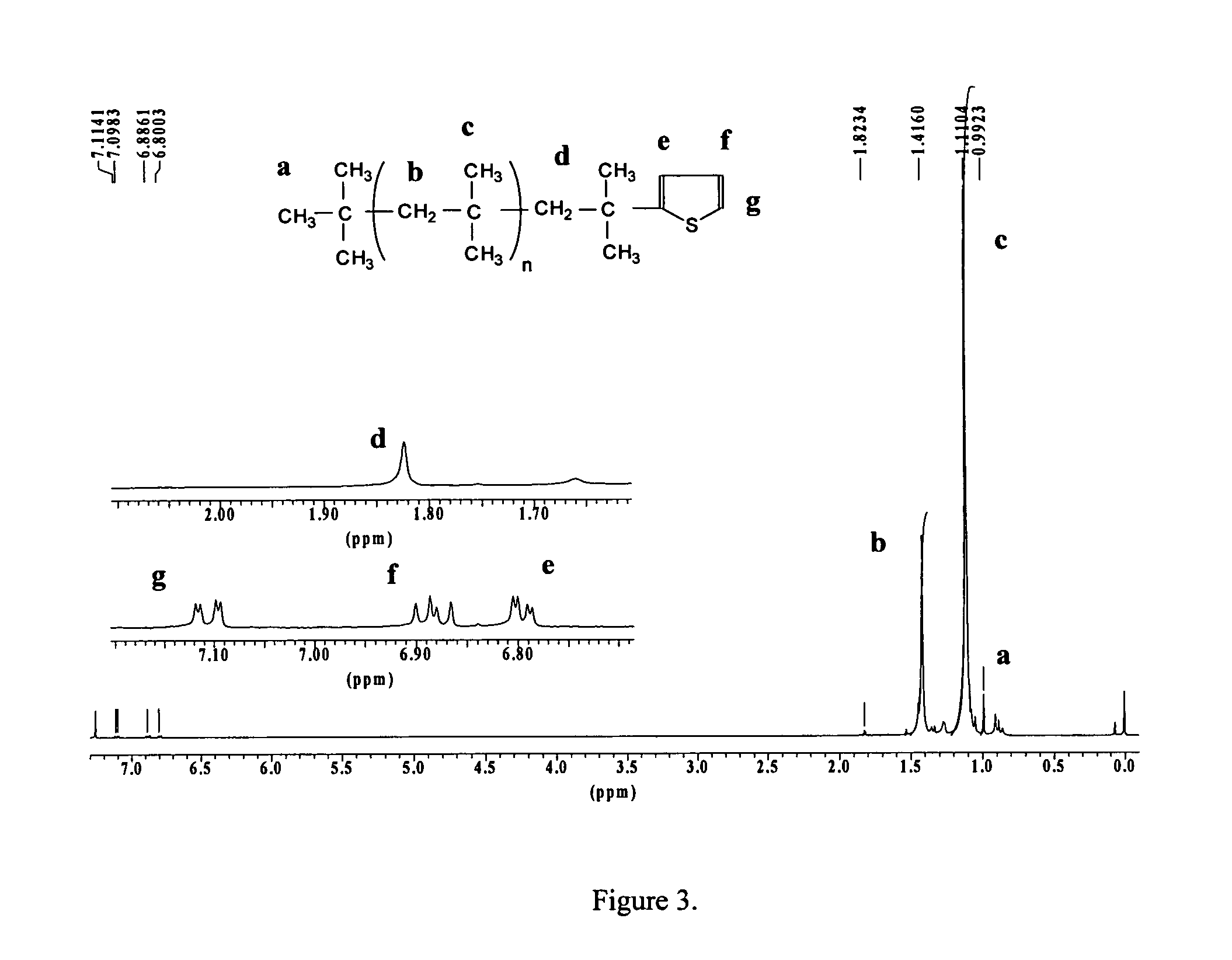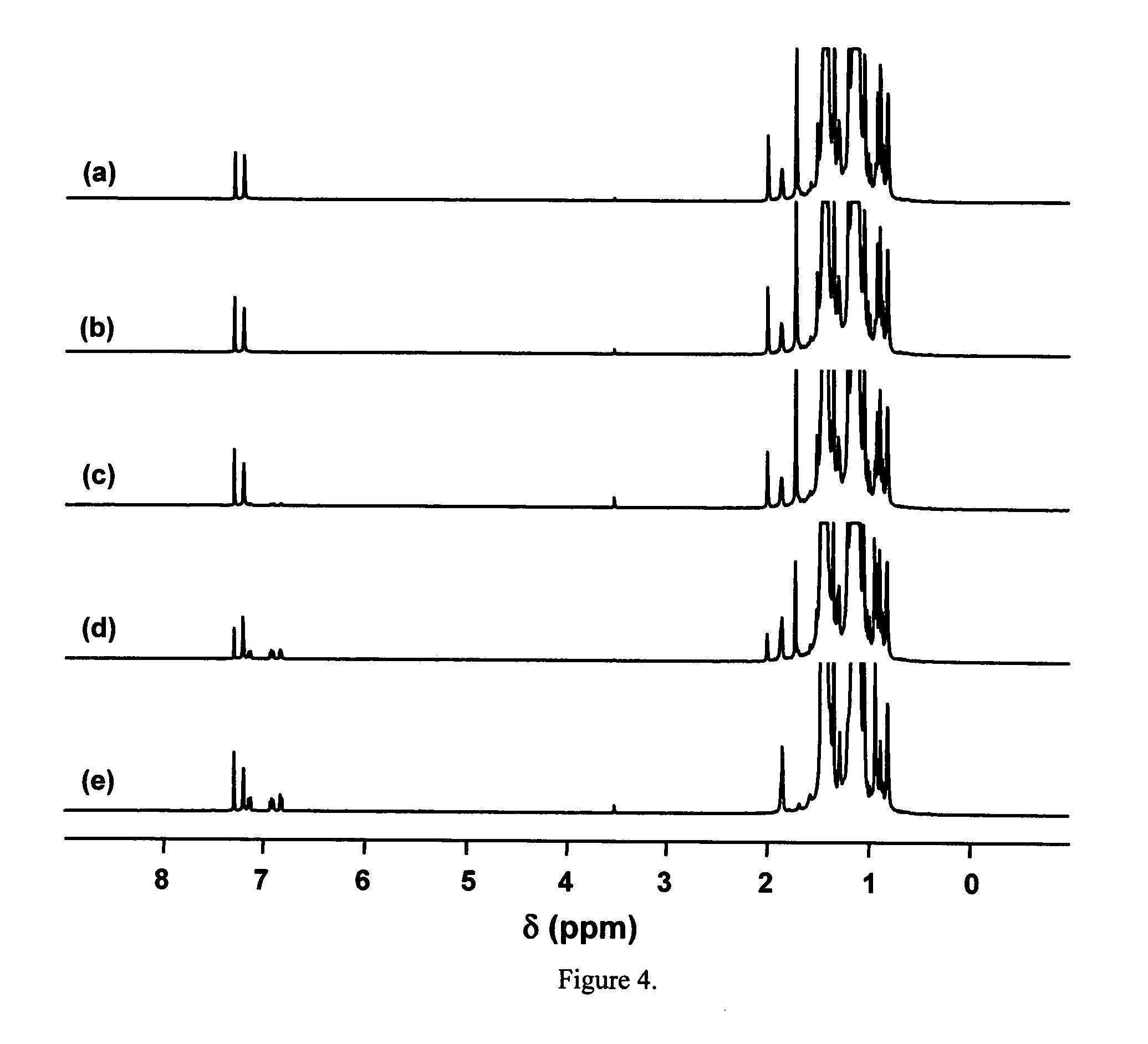End-capped polymer chains and products thereof
a polymer chain and end-cap technology, applied in the field of end-cap polymer chains, can solve the problems of inconvenient metalation with alkali metals, ineffective lithiation of dpe end-cap pib by alkyllithium, and inability to quantitatively lithiate end-cap pib, and achieve the effect of improving reactivity
- Summary
- Abstract
- Description
- Claims
- Application Information
AI Technical Summary
Benefits of technology
Problems solved by technology
Method used
Image
Examples
example 1
End-Capping of PIB with Thiophene
[0049] Model experiments with TMPCl. Orienting model experiments were carried out with TMPCl, which mimics the end group structure of tert-chloro-terminated PIB and the living chain ends upon addition of TiCl4 as a Lewis acid. These reactions were carried out in order to investigate the end-capping with T. The 1H NMR spectrum of 2-(1,1,3,3-tetrametylbutyl) thiophene is shown along with the assignments in FIG. 1. The resonances identified in the aromatic range at 6.82 (1H on Cd), 6.89 (1H on Ce), 7.10 (1H on Cf) confirmed one thiophene ring substituted by the TMP residue. In the aliphatic region the 1H NMR spectral assignments are as follows: 0.81 ppm (s, 9H, CH3), 1.44 ppm (s, 6H, CH3), 1.73 ppm (s, 2H, CH2), 6.82 ppm (m, 1H, thiophene CH), 6.89 ppm (m, 1H, thiophene CH), 7.10 ppm (m, 1H, thiophene CH).
[0050] Synthesis of Thiophene-Ended PIB (PIB-T). It was of interest to determine whether the end-functionalization results obtained with the model c...
example 2
Synthesis of α,ω-Dithiophene-Ended PIB (T-PIB-T).
[0053] Polymerizations were initiated with the difunctional initiator 5-tert-butyl-1,3-bis(1-chloro-1-methylethyl)benzene (tBuDiCumCl). After completion of IB polymerization, equal volumes of the polymer solution in the reactor were delivered into culture tubes. To each culture tube additional amount of TiCl4 or DtBP was charged to vary the ratio of [TiCl4] to [tBuDiCumCl] or [DtBP]to [tBuDiCumCl] in the polymer solution. The functionalization of PIB was conducted by two different methods: addition of T / CH3Cl solution into the polymer solution (T to polymer) and addition of the polymer solution into T / CH3Cl solution (polymer to T). 200 equiv. of T was used for the functionalization of PIB. After 1 h, the reaction mixture was quenched with prechilled methanol and poured into methanol. The polymer was purified by the precipitation of the polymer solution into methanol, followed by drying in vacuum.
[0054] Effect of the ratio of [TiCl4]...
example 3
Lithiation of PIB-T
[0058] Lithiation of the Model Compound 2-(1,1,3,3-tetrametylbutyl)thiophene (TMP-T). Orienting model experiments were carried out with TMP-T which mimics the end group structure of PIB-T. These reactions were carried out in order to optimize the lithiation of PIB-T and to predict the stability of the anionic chain ends, PIB-T−,Li+, at elevated temperature. One consequence of incomplete lithiation is the presence of unreacted precursor together with the desired block copolymer. Moreover, unreacted n-BuLi can separately initiate anionic polymerization (e.g., polymerization of tBMA) or it can attack ester groups by a nucleophilic substitution. See Hsieh, H. L.; Quirk, R. P. Anionic Polymerization. Principles and Practical Applications; M. Dekker: New York, 1996. The easiest way to remove excess n-BuLi is to heat the THF solution, since n-BuLi reacts with THF at elevated temperature, forming ethylene and alkoxides. See Jung, M. E. Blum., R. B. Tetrahedron Lett. 1977...
PUM
| Property | Measurement | Unit |
|---|---|---|
| Temperature | aaaaa | aaaaa |
| Temperature | aaaaa | aaaaa |
| Polymeric | aaaaa | aaaaa |
Abstract
Description
Claims
Application Information
 Login to View More
Login to View More - R&D
- Intellectual Property
- Life Sciences
- Materials
- Tech Scout
- Unparalleled Data Quality
- Higher Quality Content
- 60% Fewer Hallucinations
Browse by: Latest US Patents, China's latest patents, Technical Efficacy Thesaurus, Application Domain, Technology Topic, Popular Technical Reports.
© 2025 PatSnap. All rights reserved.Legal|Privacy policy|Modern Slavery Act Transparency Statement|Sitemap|About US| Contact US: help@patsnap.com



